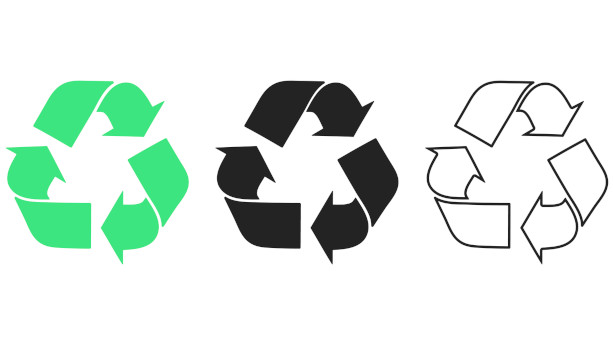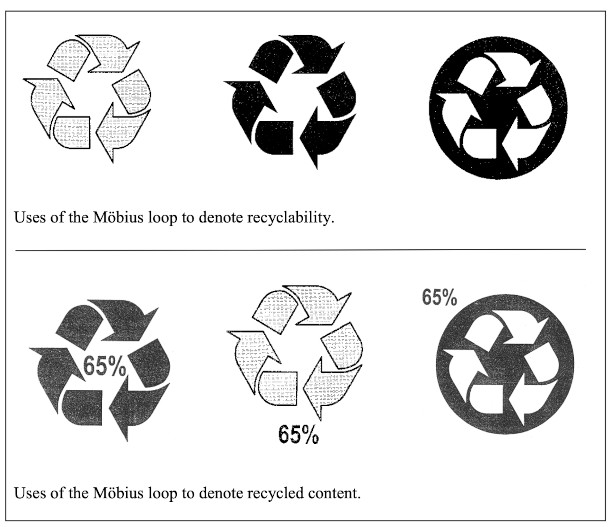
The Möbius loop is a widely recognized symbol that generally indicate packaging recyclability. The requirements for using the Möbius loop symbol differ depending on whether you sell in the EU, US, or UK.
For example, some regulations – such as 16 CFR Part 260 in the US – set requirements and guidance on how to use the Möbius loop symbol. For instance, importers and manufacturers might need to provide proof of their packaging’s recyclability or qualify their recyclability claims.
In short, you should not use the Möbius loop symbol unless you have something to support it. Even then, the requirements are not always crystal clear.
In this guide, we explain the meaning of the Möbius loop symbol, and how guidance regarding its usage varies across the EU, the US, and the UK.
Note that we always refer to “packaging” because, in the official documents we could find, the provided examples usually concern packaging products (e.g. cardboard boxes or food containers).
Content Overview

FREE CONSULTATION CALL (US, EU & UK)
- Request a free 30-minute call with Ivan Malloci to learn how we can help you with:
- Find product requirements
- Certification and labeling
- Lab testing
What is the Möbius loop?
The Möbius loop is a symbol composed of three chasing arrows. In 1970, the Container Corporation of America (CCA) held a competition to design a symbol that would promote recyclability.
In response, a young student from the University of Southern California drew inspiration from the Bauhaus architectural movement and the Möbius strip and designed a symbol consisting of three separate arrows that looped back on themselves in a triangular fashion.
Also known as the “Universal Recycling Symbol”, the Möbius loop symbol visually represents a continuous cycle consisting of clearly identifiable process stages, namely “reduce, reuse, recycle”.
What is the meaning of the Möbius loop?
The Möbius loop symbol generally indicates a packaging’s recyclability. According to 16 CFR Part 260.13, the symbol on a packaging might inform the consumer that thepackaging material is recyclable and, additionally, made from recycled material.
Further, a Möbius loop symbol accompanied by a percentage figure might indicate the percentage of the packaging that is made of recycled material.
For instance, if a food product plastic container features the Möbius loop symbol and a percentage of 40% next to it, consumers might think that the container can be recycled and that it is partially made from recycled plastic.
European Union
Based on our findings, importers, and manufacturers are not required to use the Möbius loop symbol in the EU, as there are no specific directives that mandate its usage.
However, if you do use the symbol on your packaging, you:
a. Might need to prove that the packaging is recyclable, or made of recycled materials.
b. Cannot mislead consumers by using the Möbius loop symbol on a non-recyclable packaging.
Unfair Business-to-consumer Commercial Practices Directive (UCPD)
This directive covers unfair business-to-consumer commercial practices prior to, during, and following a commercial transaction of a product, including packaging.
The UCPD has two main principles:
a. Claims of recyclability must not mislead consumers, and so, must be fact-based, not contain deceptive information, and be provided in an obvious, distinct, precise, and explicit manner.
b. Importers and manufacturers must be able to provide supporting evidence of their recyclability claims, upon request.
ISO 14021
According to Footnote 297 of this guidance document concerning the UCPD, international standards such as ISO 14021 on environmental labels and declarations reflect the above principles. Thus, they can be used to comply with the requirements set by the UCPD.
For example, as noted in the guidelines featured in the next section, ISO 14021 sets requirements for the Möbius loop usage.
As such, the UCPD does not directly set requirements for using the Möbius Loop, but it does mention ISO 14021 which in turn covers the symbol.
Guidelines for Making and Assessing Environmental Claims
Per the European Commission’s Guidelines for the Assessment of Environmental Claims, the Möbius loop symbol indicates either “recyclability” or “recycled content”, when it contains a number with a percentage (e.g. 65%).
The Guidelines document provides the following image showcasing examples of permitted versions of the Möbius loop:

Additionally, the document recommends the provision of an explanatory statement alongside the usage of a Möbius loop, as consumers might not be familiar with the meaning of the symbol. It also recommends the usage and design of the Möbius loop to meet ISO 14021’s requirements.
Finally, it provides examples that show how you can avoid conveying false information to consumers.
Example:
An aluminium foil packaging has a large Möbius loop with a “30%” qualifying statement, indicating that the goods contain 30% recycled material. However, it is not clear whether the symbol refers to the packaging or to the aluminium contained in the box. Either a more adequate size and position for the symbol is selected, such as a smaller symbol placed in a lateral position which conveys that the claim refers to the packaging, or a qualifying statement such as “recycled cardboard” is made together with the symbol.
Source: Guidelines for the Assessment of Environmental Claims
Italy
According to the CONAI’s Guidelines for Voluntary Environmental Labelling, companies can self-claim their packaging’s recyclability and affix the Möbius loop symbol, so long as they adhere to EN ISO 14021’s requirements.
United States
According to our knowledge, there are no federal regulations in the US mandating the use of a Möbius loop. There are, however, guides that govern how the symbol should be used.
16 CFR Part 260 – Guides for the Use of Environmental Marketing Claims
These guides help marketers avoid providing deceptive or unfair environmental marketing claims.
According to 16 CFR Part 260.13, which covers the provision of recycled content claims, you can make:
a. An unqualified claim, if the entire packaging product consists of wholly recycled content.
b. A qualified claim, if the packaging is both recyclable and is made using recycled content.
Example 8 under 16 CFR Part 260.13 concerns the usage of a Möbius loop symbol without explanation on a packaged food product. Used alone, consumers might interpret the symbol to mean that the packaging can be recycled and is made wholly of recycled material.
Example 8:
A packaged food product is labeled with a three-chasing-arrows symbol (a Möbius loop) without explanation. By itself, the symbol likely conveys that the packaging is both recyclable and made entirely from recycled material. Unless the marketer has substantiation for both messages, the claim should be qualified. The claim may need to be further qualified, to the extent necessary, to disclose the limited availability of recycling programs and/or the percentage of recycled content used to make the package.
Source: 16 CFR Part 260
The claim should be qualified if the marketer has no evidence that both messages are true. You might need to further qualify your claim, for instance, to disclose the percentage of recycled content used in the package or the limited availability of recycling programs.
You may also need supporting documentation, such as test reports.
Resin Identification Codes (RIC) – State Regulations
Resin Identification Codes (RICs) were first established by the Society of the Plastics Industry, Inc. (SPI) and are currently administered by ASTM International. The ASTM D7611/D7611M standard specifies guidelines for RICs, which are used to identify and differentiate between seven types of plastic resins (eg. HDPE), with the purpose of sorting materials in an efficient fashion.
PLASTICS, formerly the SPI, conducted a survey in 2022 and found that 29 US states require the RIC chasing arrows symbol to aid visual sortation of different types of plastic packaging products. For example, Massachusetts requires the chasing arrows RICs to visually aid the sortation of plastic bottles and rigid plastic packaging.
The usage of the chasing arrows for the RICs was never meant to indicate the “recyclability” of rigid plastics. ASTM understood that using the chasing arrows in the RIC’s design could confuse consumers, as their design is very similar to the the Möbius loop.
As such, it replaced the chasing arrows with an equilateral triangle in its ASTM D7611/D7611M standard. However, to our knowledge, many states never updated their requirements for the symbol, and thus they continue to use the old chasing arrows symbol.
What’s the difference between RICs and the Möbius loop?
As explained above, the design of the RIC symbols originally featured three chasing arrows, similar to the Möbius loop symbol, and a code that specifies the type of material.
In order to avoid confusion, ASTM updated the RIC symbol from the three chasing arrows to an equilateral triangle with a “bold outline”. As such, RIC symbols:
- Include a solid equilateral triangle in their design
- Include information about the material
- Aid recyclers in sorting materials for collection
- Do not indicate recyclability
Conversely, the Möbius loop symbol:
- Is composed of three chasing arrows
- Might indicate that a packaging product is recyclable
- Might indicate that a packaging product is made of recycled material (and in which percentage, e.g. 50%)
United Kingdom
According to our research, the provision of the Möbius loop is not mandatory in the UK. However, the Competition and Market Authority published a Guidance document informing companies that if they make environmental claims, they should also ensure that they are able to provide evidence to back up those claims.
Companies should also exercise caution when using logos to make environmental claims, as the logo’s impression may mislead even though its message is factually correct.
Green Claims Guidance
In 2011, the Department for Environment, Food and Rural Affairs (DEFRA) published a Green Claims Guidance document on how companies should and should not make environmental claims.
Their three most basic requirements for such, are that environmental claims must be:
- Clear
- Accurate, and
- Substantiated
Example of good practice
Regarding clarity and accuracy, companies using the Möbius loop must use it correctly and might need to provide an additional clarification statement.
For instance, the DEFRA’s Guidance document provides an example of good practice, which includes the explanatory statement “This cardboard box is widely recyclable in the UK” in the packaging label, alongside the Möbius loop.
The Guidance document also notes that the Möbius loop should only appear on “recyclable” packaging products.



















